Fallingwater, The Kaufmanns and Bear Run:
A Conversation with Lynda Waggoner
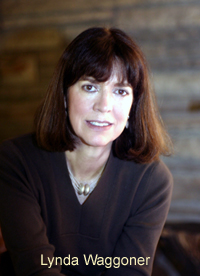 Lynda S. Waggoner, the Western Pennsylvania Conservancy's Vice President
and Director of Fallingwater, has been affiliated with the Frank Lloyd Wright masterwork since first serving as a tour guide during her high school days. She now is widely regarded as one of the nations foremost authorities on Fallingwater. A native of nearby Farmington, Waggoner returned to Fallingwater in 1985 as a curatorial consultant and became full-time curator in 1986. A year later, she was named site administrator in addition to her
curators role. She was named director in 1996. Lynda S. Waggoner, the Western Pennsylvania Conservancy's Vice President
and Director of Fallingwater, has been affiliated with the Frank Lloyd Wright masterwork since first serving as a tour guide during her high school days. She now is widely regarded as one of the nations foremost authorities on Fallingwater. A native of nearby Farmington, Waggoner returned to Fallingwater in 1985 as a curatorial consultant and became full-time curator in 1986. A year later, she was named site administrator in addition to her
curators role. She was named director in 1996.
As American Institute of Architects Member Robert Bailey said in reviewing Waggoners book, Fallingwater: Frank Lloyd Wrights Romance with Nature, Lynda Waggoner understands Fallingwater in a way that few others alive do because she is a direct link to the Kaufmanns and an indirect link to Wright. In this conversation, Waggoner talks about the Kaufmann family’s love of Fallingwater and Bear Run.
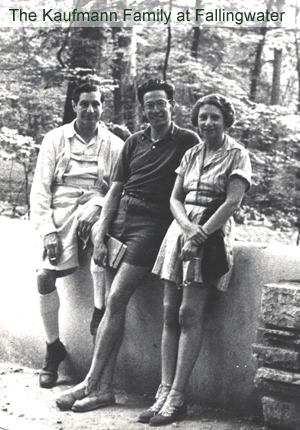 CONSERVE: How did the Kaufmanns find Bear Run? CONSERVE: How did the Kaufmanns find Bear Run?
LW: Edgar Kaufmann was apprenticing in a department store in Connellsville. Bear Run
was a recreational area where people in the lowlands, like Connellsville, would often
hike in the mountains on their day off.
CONSERVE: And they offered use of the land to their employees from Kaufmanns
Department Store in Pittsburgh?
LW: Thats right. It was called the Kaufmanns Summer Club. Before they
owned the land, it had been a Syria Club, owned by the Masons and so the structures
were already in place. Then the Kaufmanns leased and eventually bought the property.
The summer camp was established in 1916 and they bought the property in 1918. In the
early 20s, there were pieces of property they acquired over time. They just kept buying
land. It was a vacation spot for lady employees with hiking, camping, swimming,
hayrides and picnicing. That was a time when Pittsburgh was very polluted and a trip
to the mountains was appreciated. They most likely arrived by train. There was
actually a stop called Bear Run, which was one of many whistle stops of little towns that
sprung up and existed because of the railroad. These towns have disappeared but
thats how people got around since the roads were really not well developed yet.
CONSERVE: A whistle stop would only
stop if someone was waiting or getting off at that stop.
LW: Apparently.
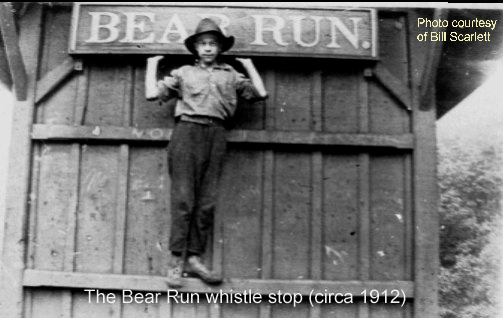
CONSERVE: And they would come up on
the weekends?
LW: And in the summer they would spend a
week or two at a time. But they used it year-
round. The Kaufmanns shared this belief
with Frank Lloyd Wright that man should live in harmony with nature and Fallingwater is a great example of how it could be achieved.
CONSERVE: What did the Kaufmanns like to do at Bear Run?
LW: Mrs. Kaufmann liked to fish. They liked hiking. They loved swimming. It was a getaway. It was just being in touch with nature in a beautiful place. They read. The library here at Fallingwater is pretty extensive. They entertained their guests, but
not big entertainment. It was usually just a couple or a few people out at a time. The
space is not designed to handle that many people.
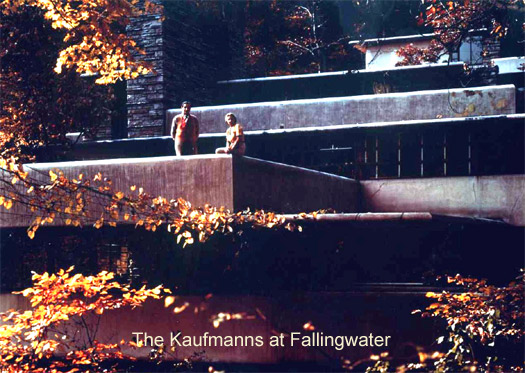
CONSERVE: Did you ever meet Edgar Kaufmann jr (sic)?
LW: Oh yes, I worked with him closely for many years. He had very clear ideas about
how this house should be operated and presented to the public. And he was really
ahead of his time in terms of how he looked at the artifact itself, the building and the
collections. He saw the site as an integral part of the building and thats one of the
reasons why he chose to entrust Fallingwater to the Western Pennsylvania Conservancy.
He knew that unlike most historical or museum organizations that had developed in
this country, WPC would pay attention to the site; and they did.
CONSERVE: You started as a tour guide at Fallingwater, is that right?
LW: I was a tour guide in high school and summers when I was in college. Then I was
gone for about ten years working in other art-based venues as a curator or administrator.
CONSERVE: As a tour guide, would Edgar Kaufmann jr. speak to all of you?
LW: He would talk to us formally as a group. When I came back in 1985 as a curator, Tom
Schmidt, the director of Fallingwater, and I worked with him one on one until he passed
away in 1989. We would go to New York; he would come here. We would meet often.
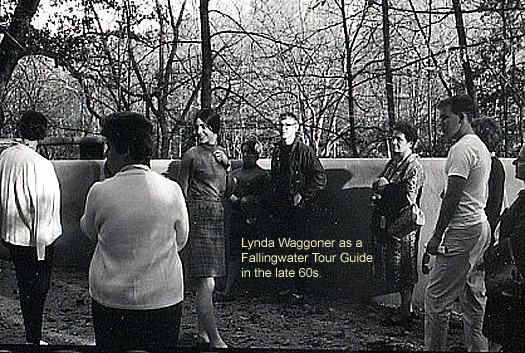
CONSERVE: What would he tell you during those meetings?
LW: He was very concerned that we not treat 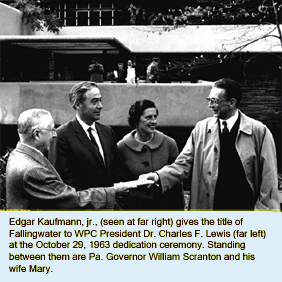 Fallingwater like a museum in the sense
that he wanted visitors to be able to experience the space within the house. He
was very clear that rooms were not to be cordoned off as they are in many museums
where you just look in through the doorway or walk on a guided path with stanchions
protecting the collections from the visitors. He felt you had to experience the whole
house. He always wanted it to look fresh and lived in. He didnt want it to get stale or
have a sense of being encased in glass. So we do things like having fresh flowers
arranged the way Mrs. Kaufmann liked them and we change the upholstery when it gets
tired and thats almost a no-no nowadays in an historic house. But it was really
important to Mr. Kaufmann. He believed if Fallingwater was kept fresh, it would continue to thrill and inspire people instead of becoming a relic of the past. Fallingwater like a museum in the sense
that he wanted visitors to be able to experience the space within the house. He
was very clear that rooms were not to be cordoned off as they are in many museums
where you just look in through the doorway or walk on a guided path with stanchions
protecting the collections from the visitors. He felt you had to experience the whole
house. He always wanted it to look fresh and lived in. He didnt want it to get stale or
have a sense of being encased in glass. So we do things like having fresh flowers
arranged the way Mrs. Kaufmann liked them and we change the upholstery when it gets
tired and thats almost a no-no nowadays in an historic house. But it was really
important to Mr. Kaufmann. He believed if Fallingwater was kept fresh, it would continue to thrill and inspire people instead of becoming a relic of the past. |


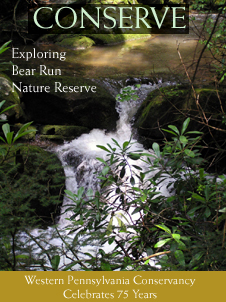


 CONSERVE: How did the Kaufmanns find Bear Run?
CONSERVE: How did the Kaufmanns find Bear Run? 


 Fallingwater like a museum in the sense
that he wanted visitors to be able to experience the space within the house. He
was very clear that rooms were not to be cordoned off as they are in many museums
where you just look in through the doorway or walk on a guided path with stanchions
protecting the collections from the visitors. He felt you had to experience the whole
house. He always wanted it to look fresh and lived in. He didnt want it to get stale or
have a sense of being encased in glass. So we do things like having fresh flowers
arranged the way Mrs. Kaufmann liked them and we change the upholstery when it gets
tired and thats almost a no-no nowadays in an historic house. But it was really
important to Mr. Kaufmann. He believed if Fallingwater was kept fresh, it would
Fallingwater like a museum in the sense
that he wanted visitors to be able to experience the space within the house. He
was very clear that rooms were not to be cordoned off as they are in many museums
where you just look in through the doorway or walk on a guided path with stanchions
protecting the collections from the visitors. He felt you had to experience the whole
house. He always wanted it to look fresh and lived in. He didnt want it to get stale or
have a sense of being encased in glass. So we do things like having fresh flowers
arranged the way Mrs. Kaufmann liked them and we change the upholstery when it gets
tired and thats almost a no-no nowadays in an historic house. But it was really
important to Mr. Kaufmann. He believed if Fallingwater was kept fresh, it would